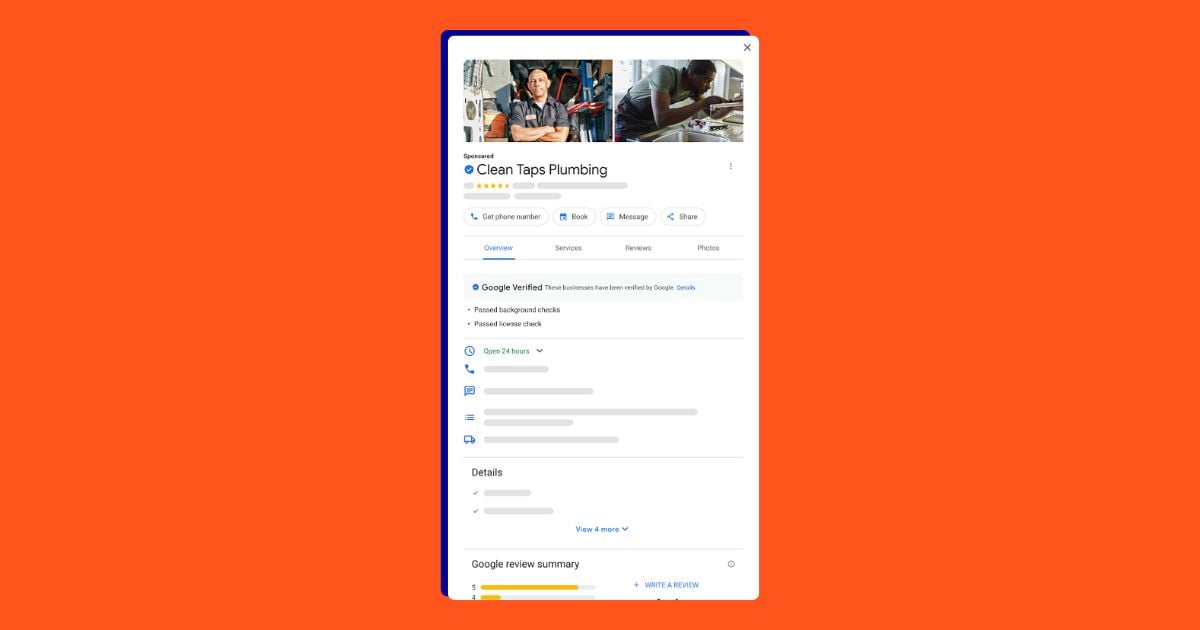I have good news and bad news. The bad news is every advertiser has a budget they need to stick to. The good news is you can stay within budget by getting selective with where your money is going. Literally. We’re talking geotargeting.
Geotargeting is a form of targeting by location that lets your ads only appear to customers in a certain physical place, or set of places, that you specify. That way, your money goes to the right place every time.
In this guide, I’m going to show you exactly how to do just that in Google Ads. We’ll cover:
- Why and how to use geotargeting (other than just to save money!)
- How to set up a geotargeting campaign in Google Ads
- 10 tips on how to maximize your local PPC performance.
Let’s get started!
Why & how to use geotargeting for local PPC
When you first create a campaign in Google Ads, it automatically defaults to all countries and regions. Last I checked, no business is a fit for every single human on earth, so you need to select at least some form of geotargeting—even if it’s as broad as it can get. But there are additional benefits to geotargeting that we also want to parse out.
Save money
The most obvious reason for geotargeting is that you can avoid wasting ad spend on consumers who may qualify for your services but are not located in an area you serve. And this targeting can be as wide or narrow as you need. For example:
- An online retailer might target the entire US, or only states with major cities.
- A chain of nursing homes in New England can target only those states.
- A home service business can target the specific neighborhoods they serve.
You can also exclude locations dominated by a competitor.
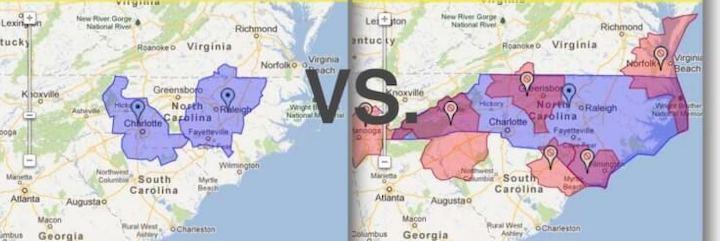
Find more ways to save money with our free Google Ads Performance Grader!
Deliver super-personalized experiences
With geotargeting for local PPC, you can relate your offering to local events or use language that resonates with that community. For example, if you know there’s a concert in your town, you may want to run a special promotion for your restaurant nearby.
Segment to reach the right person
Say you’re a landscaper whose ideal customers are wealthy estate owners. With geotargeting, you could target the more affluent areas of a particular region. (Note: there are some industries that may not be able to layer demographic and location targeting together.)
Get your timing right
When it comes to timing, you may think of ad scheduling but geotargeting also has a use here. Commonly referred to as geofencing, you can serve particular ads to people upon entering or exiting a geographic boundary. This could be useful if there’s a week-long conference going on near your business.

Test out new markets
Run lower budget campaigns in new areas to test the waters and if you end up performing well, create more lower-funnel ads. Keep in mind that geotargeting is only available at the campaign level. So, if you’re curious about how you would perform in a new market, split up your locations by campaign.
Align with consumer trends
Geotargeting is a win-win. Not only do you save money, but this is what consumers want! According to research:
- 80% percent of consumers say that they would like to get location-based alerts from businesses.
- 70% of consumers say that they are willing to share their location if they get something valuable in return.
- 61% of smartphone owners prefer to buy from sites that customize information for their location.
In short, you’re taking your local PPC strategy to the next level to give consumers a personalized, local-friendly experience—all while saving money!
How to set up location targeting in Google Ads
To implement geotargeting in Google Ads, select the campaign you wish to target, click on the Settings tab, then scroll down to the Locations section.
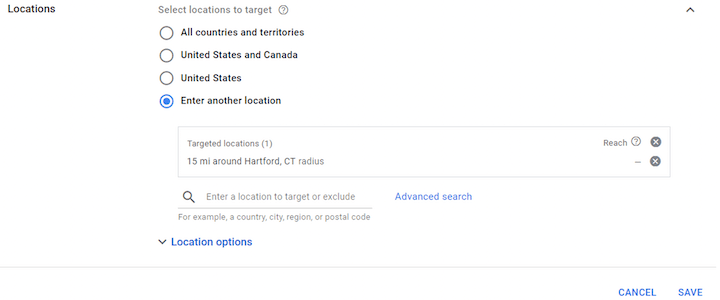
Click the Search bar, start typing in your desired location, and select it when it appears on the drop-down menu of relevant matches. Options include country, region (such as state or province), city, postal code, and even certain airports.
If you click Advanced Search, you’ll be brought to a separate pop-out box that gives you three more options:
- Add: adds that location to your list of targeted locations.
- Exclude: prevents your ads from appearing in this location.
- Nearby & Related Locations: generates a list of nearby regions that you might consider adding as well.
When you select a region, Google Ads will display a map with the targeted area highlighted.
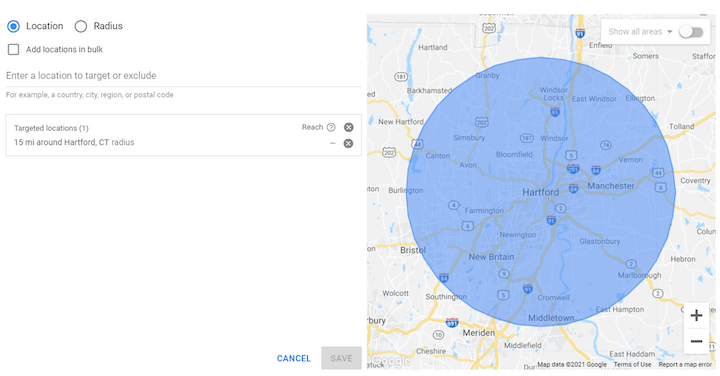
If you have multiple regions selected, they’ll all appear on a list, and you can zoom out the map to view all.
10 tips to maximize your advertising ROI with geotargeting
Geotargeting can positively impact metrics like your Quality Score, impression share, and click-through rate. Here are 10 of my top geotargeting tips to improve your performance across the board.
1. Double-check your location options
When setting up your geotargeting, there is one nuance to pay attention to. When you click into the blue Location options tab, you can target by Presence (people in or regularly in your targeted locations), Search interest (people searching for your targeted locations) or both.
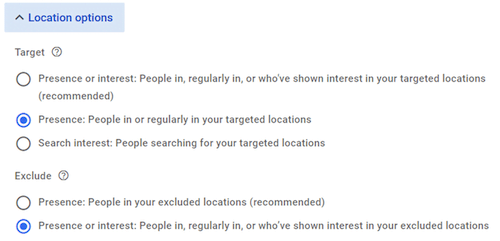
Google is sneaky in that it can default to the top option: showing to people in, regularly in, OR showing interest in your targeting locations.
For some businesses, this is ideal. For example, a senior living facility can show ads to adults who don’t live in, but frequent a particular area to visit their parents.
But in other cases, this can lead to locations showing up in your locations report that you don’t want to target.
For example, let’s say you only want to target Miami residents. If the first option is checked, your ad may show for someone located in Boston who’s planning a vacation to Miami (frequently looking up attractions in Miami).
2. Keep an eye on granular location metrics
See which locations are generating the most traffic by clicking on the Locations tab in the second navigation column. Here you can view standard information such as clicks, impressions, average cost-per-click (CPC), and average position, as it applies to each of your specified locations.
This is important for understanding exactly where you’ll get the highest ROI.

3. Seek out and implement location-based negatives
Use the Search Terms Report to see which keyword searches triggered your ads. If you notice keywords from outside your target locations are triggering your ads, exclude these keywords by clicking the check box next to them, then selecting Add as a negative keyword.
For example, if you run a car dealership in Chicago but your ads are being triggered by searches for “new cars Boston,” add the word “Boston” to your negative keyword list to avoid your ads being triggered by further searches for Boston. To bring up the Search Terms Report, go to the Campaigns tab, click Keywords, then Details, and select All from the drop-down menu to bring up the report for all keywords in the campaign.
4. Use bid adjustments to lower CPA
If you’re on a manual bidding strategy, you can apply bid adjustments to toss Google more or less money per click when you show to a user with a specific location. In the Locations section, you’ll see a bid adjustment column where you can apply a negative or positive percentage on top of your original keyword bids for the selected area.
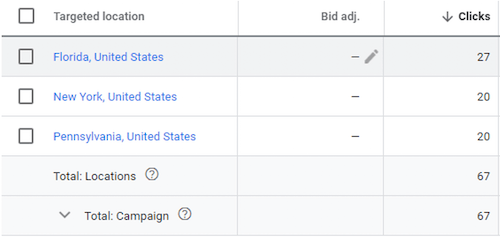
An example would be if you know you’re more or less likely to get a high return from consumers within a specific city or state, clicks coming from those areas could be of different value to you.
Bid adjustments help you to customize your original keyword bid accordingly. This will help you get the biggest bang for your buck (in other words, lower your CPA) since you’ll be able to avoid pricier clicks from less popular areas your business caters to, while also ensuring you rank for your priority places.
5. Don’t be afraid to be picky
It’s always helpful to remember that PPC spend is coming out of your own (or your client’s) pockets. So, put forth paid efforts with that always in mind. That means if you ship all over the country but really only see sales coming from a few select cities, then only geotarget those places—and let your organic listings take care of the less valuable stragglers from other parts.
It can be tempting to “cast a wide net,” but when you take a step back to prioritize your top-performing locations you’ll see costs go down without losing out on conversions.
6. Don’t forget to exclude certain locations
Now, you don’t have to go crazy excluding every location you’re not geotargeting—that defeats the purpose! But, if you have a specific location that maybe is close by to your target or is a red-flag (or disapproval) issue if you ever showed there, then you’ll want to cover your own butt and exclude it ahead of time.
Speaking of disapprovals: make sure you know all the details about Google’s new three-strikes policy program!
7. Use Google Trends to inform your geotargeting strategy
Google search interests change constantly. On top of this, consumer priorities and needs have shifted significantly due to the pandemic.
Google Trends is a tool that can show the interest people have in a certain keyword or topic within a particular geographic area. So, you’ll be able to see what keywords might work best in combination with your geotargeting.

8. Include regional terms in your keyword lists
Think of this as icing on the geotargeting cake. While your geotargeting is already going to take care of who you show to based on location it never hurts to layer on some location-based keywords. This will go along with your ad copy and (most likely) the searcher’s query.
So, including regional terms could give you a quality score boost since your keywords will be even more relevant. For example, try out a term like “contractors in boston” instead of just “best contractors” because someone searching locally will most likely be using their location as part of the query.
9. Include the name of your target location in your ad copy
This is a best practice with local PPC so your viewers know right off the bat that you cater to their location. A bonus would be if you can squeeze it into a headline because the matching ad text will appear in bold. This helps the ad stand out on the page as a local-friendly listing.
Remember, odds are the searchers are looking up queries that include your targeting location. And if you’re also using geotargeted keywords as mentioned above this effort will kick up your ad’s relevancy since you’ll be following the best practice of including the keyword in the headline. A boost in relevancy will help your ad to rank higher on the SERP.

10. Use location extensions and call extensions
Location extensions let you display your business’s address with the ad, and call extensions display a phone number. This is win-win because it’s already a best practice to include ad extensions in your search ad strategy since they will build off your ad as they serve to help you take up more SERP real estate and catch your audience’s eye.
On top of this, people searching locally most likely are looking for immediate information while they’re on-the-go in your targeted location. So, these two local-specific ad extensions will make it easier for potential customers to find and contact you.

Use Google Ads location targeting to focus your spend where it counts
Not only can geotargeting save you money with local PPC, but it can also be a tool for personalized and real-time marketing, testing out new markets, and targeting personas in a given neighborhood. Follow these tips to get the most out of geotargeting in Google ads in your local business advertising:
- Double-check your location options
- Pay attention to granular metrics
- Seek out and implement location-based negatives
- Use bid adjustments to lower CPA
- Don’t be afraid to be picky
- Exclude certain locations
- Use Google Trends to inform your targeting
- Include regional terms in your ad copy
- Include the name of your target location in your ad copy
- Use location extensions and call extensions


